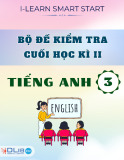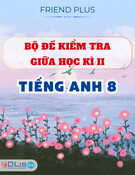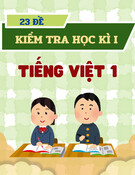
S GD VÀ ĐT QU NG NGÃIỞ Ả
TR NG THPT CHU VĂN ANƯỜ
(Đ thi có 07 trang)ề
K THI TRUNG H C PH THÔNG QU C GIA NĂMỲ Ọ Ổ Ố 2018
Bài thi môn: TI NG ANHẾ
Th i gian làm bài: 50 phút, không k th i gian phát đờ ể ờ ề
Mark the letter A, B, C, or D on your answer sheet to indicate the word whose
underlined part differs from the other three in pronunciation in each of the
following questions.
Câu 1:
1.A. wounded B. combined C. considered D. believed
Câu 2:
2.A. mission B. revision C. division D. collision
Mark the letter A, B, C, or D on your answer sheet to indicate the word that differs
from the other three in the position of primary stress in each of the following
questions.
Câu 3:
3.A. academic B. inorganic C. understanding D. uncertainty
Câu 4:
4.A. disappear B. recommend C. understand D. volunteer
Mark the letter A, B, C, or D on your answer sheet to indicate the underlined part
that needs correction in each of the following questions.
Câu 5:(A)The shopkeeper warned the boys (B) don’t lean (C) their bicycles (D) against
his windows
Câu 6:(A)The people who (B) they hadn’t seen the weather forecast (C) were caught
(D) unaware by hurricane
Câu 7: No longer (A) satisfied with the (B) emphasis of the Denishawn school, Martha
(C) has moved to (D) the staff of the Eastman school in 1925
Mark the letter A, B, C, or D on your answer sheet to indicate the correct answer to
each of the following questions.
Câu 8: The preparation __________ by the time the guest ________
A. have finished- arrived B. had been finished- arrived
C.had finished- were arriving D. have been finished- were arrived
Câu 9: He does not______ his fellow-workers and there are often disagreements between
them

A. get on with B. put up with C.go on with D. take to
Câu 10: Jupiter is _______ planet in the solar system.
A. the biggest B. the big C. the bigger D. biggest
Câu 11: Tommy wanted to know ______ .
A. why his friends laughing B. why did his friends laugh
C. the reason why his friends laughing
D. why his friends were laughing
Câu 12: Clask has a wide ______ about cultures of many countries in the world
A.known B.knowing C. knowledge D.know
Câu 13: Education in England puts ______ force for children from 9 to 16 years old.
A. into B. on C. off D. through (thu x p)ế
Câu 14: If he had known her address, he_______ her to his birthday party last week.
A.would have invited B. would have invite
C. will invite D. would invite
Câu 15: Students who study far from home often have problems with _______.
A. houses B. rooms C. flats D. accommodation
Câu 16: In his latest speech, the Secretary General_______ the importance of wildlife
conservation.
A. stressed B. excused C. extorted D. remained
Câu 17: Some days of rest may help to _______ the pressure of work.
A. reduce B. lower C. chop D. crease
Câu 18: No one enjoys ______ in public.
A. being made fun of B. to be made fun of
C. making fun of D. to make fun of
Câu 19: _______ he arrived at the bus stop when the bus came
A. Hardly had B. No sooner had C. No longer has D. Not until had
Mark the letter A, B, C, or D on your answer sheet to indicate the most suitable
response to complete each of the following exchanges.
Câu 20: -Tom : “Would you mind holding the door open for me please?”
-Mary: “ __________”.
A.Oh, with pleasure B. ready C. You’re welcome D. I can do
Câu 21: Mary is talking to her professor in his office.
Mary: “Can tell me how to find material for my science report, professor?”
Professor: “__________”
A. I like it that you understand. B. Try your best, Mary.

C. You can borrow books from the library. D. You mean the podcasts from
other students?
Mark the letter A, B, C, or D on your answer sheet to indicate the word CLOSEST
in meaning to the underlined word in each of the following questions
Câu 22: The use of lasers in surgery has become relatively commonplace in recent years
A. Absolutely B. relevantly C. comparatively D. almost
Câu 23: From an airplane, the grasslands of the western prairie appear almost as uniform
as a placid sea.
A. hilly B.calm C. seedy D. fake
Mark the letter A, B, C, or D on your answer sheet to indicate the word(s)
OPPOSITE in meaning to the underlined word(s) in each of the following questions.
Câu 24: She decided to remain celibate and devote her life to helping the homeless and
orphans.
A. Divorced B. separated C. single D. married
Câu 25: In Western culture, It is polite to remain eye contact during conversation.
A. Irresponsible B. discourteous C. insecure D. informal
Mark the letter A, B, C, or D on your answer sheet to indicate the sentence that is
closest in meaning to each of the following questions
Câu 26: The gate was closed to stop the children running into the road.
A. The gate was closed so the children can’t run into the road.
B. The gate is closed so that the children don’t run into the road.
C. The gate was closed so that the children couldn’t run into the road.
D. The gate is closed so that the children couldn’t run into the road.
Câu 27: If it hadn’t been for the wind , the fire would never have spread so fast.
A. Even without the wind , the fire would have spread just as fast.
B. It was the wind that caused the fire to spread at such a speed.
C. Had there been a wind, the fire would have spread even fast.
D. The force of the wind affected the way the fire spread
Câu 28: “If I were you, I would go to the doctor.” David said to Claudia.
A. David advised Claudia not to go to the doctor.
B. David told Claudia that he would go to see the doctor.
C. David advised Claudia to go to the doctor.
D. David told Claudia to become a doctor.

Mark the letter A, B, C, or D on your answer sheet to indicate the sentence that best
combines each pair of sentences in the following questions
Câu 29 : I strongly disapproved of your behavior. However, I will help you this time.
A. Despite of my strong disapproval of your behavior, I will help you this time.
B. Despite my strong disapproval of your behavior, I will help you this time.
C. Because of your behavior, I will help you this time
D. Although I strongly disapproved of your behavior, but I will help you this time
Câu 30: The student was very bright. He could solve all the math problems.
A. He was such bright student that he could solve all the math problems
B. The student was very bright that he could solve all the math problems
C. He was so bright a student that he could solve all the math problems.
D. Such bright was the student that he could solve all the math prolems.
Read the following passage and mark the letter A, B, C, or D on your answer sheet
to indicate the correct word or phrase that best fits each of the numbered blanks
from 31 to 35.
In a small village in North Yorkshire, there is a big old farmhouse _____ (31) three
families live together .Alice and George and their three children, Joe and Pam and their
two children, and Sue and her baby daughter. The adults divide up the work between
them. George does the cooking, Joe and Sue do almost the housework . Pam looks after
the shopping and _______ (32) the repairs, and Alice takes care of the garden.
Alice, George and Sue go out to work, Joe works at home ________ (33) computer
systems, and Pam, who is a painter, looks after the baby during the day. Two of the
children go to school in the village, but the three oldest ones go by bus to the secondary
school in the nearest town, ten miles away.
The three families get______ (34) well, and enjoy their way of life. There are a few
difficulties, of course. Their biggest worry at the moment is money- one of the cars needs
replacing, and the roof needs some expensive repairs. But this isn’t too serious- the bank
has agreed to a loan, which they expect to be able to pay back in three years. And they all
say they would much rather go on living in their old farmhouse _______ (35) move to the
luxury flat in a big city.
31 A. that B. where C. in where D. which
32.A. does B. has C. prepares D. fulfills
33.A. designs B. and design C. designing D. who designs
34. A. on B. off C. with D. in
35.A. then B. than C. to D. therefore

Read the following passage and mark the letter A, B, C, or D on your answer sheet
to indicate the correct answer to each of the questions from 36 to 42.
Over the past 600 years, English has grown from the language of few speakers to
become the dominant language of international communication. English as we know it
today emerged around 1350, after having incorporated many elements of French that
were introduced following the Norman invasion of 1066. Until the 1600s, English was, for
the most part, spoken only in England and had not expanded even as far as Wales,
Scotland, or Ireland. However, during the course of the next two century, England began
to spread around the globe as a result of the exploration, trade ( including slave trade),
colonization, and missionary work. Thus, small enclaves of English, speakers became
established and grew in various parts of the world. As these communities proliferated,
English gradually became the primary language of international business, banking, and
diplomacy.
Currently, about 80 percent of the information stored on computer systems
worldwide is in English. Two- thirds of the world’s science writing is in English, and
English is the main language of technology, advertising, media, international airport, and
air traffic, controllers. Today there are more than 700 million English users in the world,
and over half of these are non-native speakers, constituting the largest number of non-
native users than any other language in the world.
36.What is the main topic of the passage?
A. The number of non-native users of English.
B. The French influence on the English language.
C. The expansion of English as an international language.
D. The use of English for science and technology.
37. In the first paragraph , the word “ emerged” is closest in meaning to
A. appeared B. hailed C. frequented D. engaged
38. In the first paragraph , the word “ elements” is closest in meaning to
A. declaration B. features C. curiosities D. customs
39. Approximately when did English begin to be used beyond England?____________
A. in 1066 B. around 1350 C. before 1600 D.after 1600
40. According to the passage, all of the following contributed to the spread of English
around the world EXCEPT ____________
A. the slave trade B. the Norman invasion C. missionaries D. colonization
41. In the second paragraph, the word “ stored” is closest in meaning to ___________
A. bought B. saved C. spent D. valued












![Đề thi Tiếng Anh có đáp án [kèm lời giải chi tiết]](https://cdn.tailieu.vn/images/document/thumbnail/2025/20250810/duykpmg/135x160/64731754886819.jpg)



